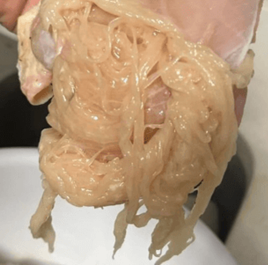| Reader, If you're like most Americans, you've probably forgotten what real chicken tastes or even feels like to eat.
And it's getting worse…  If your chicken breast looks like stringy spaghetti noodles, it's a clear sign the bird was forced to grow too fast. | If you've recently noticed that your chicken breast looks stringy, mushy, or oddly soft, you're not imagining things.
You're witnessing a growing problem in the industrial poultry industry known as "spaghetti meat."
This phenomenon isn't just a cosmetic or culinary problem.
Nor is it just about the texture of the food.
And even if you put aside the disturbing cruelty these animals suffer…
What it comes down to is the utter depletion of vital nutrients that your body needs to stay healthy.
It's true that chicken can be a good source of protein and nutrients.
But factory-farmed poultry has less nutrition than their pasture-fed relatives. Multiple studies back this up.1,2
These overfed but undernourished birds contain far LESS: - Omega-3 fatty acids
- Vitamins A, B6, D, and E
- Iron
- Selenium
- Glutathione
They also contain far more inflammation-causing omega-6 fats than omega-3s. As you know, chronic inflammation from omega-6s leads to heart disease, stroke, and cancer.
A hundred years ago – long before the development of fast-growing broilers – chickens eating a natural diet took more than four months to reach a market weight of 2.5 pounds.
Today, these birds eat calorie-dense feeds that include GMO cereal grains and soymeal.
Their diet also includes what's known as "bakery meal" – baked processed foods like bread, cookies, and crackers that were deemed not suitable for human consumption.
These industrially raised chickens weigh nearly three times as much as they used to…
Hitting an average of 6.2 pounds in just 45 days.3
That may sound like efficiency. But the truth is that it has led to severe muscle abnormalities in these animals.
Instead of firm, structured muscle tissue, chicken breasts have become stringy, weak, and shredded — and look just like spaghetti.
The cause?
These poor birds grow way too fast for their muscles to develop properly.
Studies show that spaghetti meat has more dangerous omega-6 fat, less protein, and a significantly higher moisture content, compared with traditionally raised chickens.4
That means you're paying for more water, but you're getting less of the essential protein and other important nutrients you expect from chicken.
Stringy spaghetti meat in your chicken breast is a clear symptom of a broken food system.
For years, this breakdown has produced declining nutritional standards and created a growing disconnect between consumers and their food sources.
These missing or depleted nutrients in modern food are intended as fuel for hundreds of vital functions in your body, including powering your muscles, heart, brain, immune system and sex drive... to name just a few.
That's why America's broken food-production system is also at the root of the surge in chronic illnesses, like heart disease, diabetes, Alzheimer's, and more.
You see, chickens aren't meant to live in cramped cages or eat corn, soy, and bakery meal – the ground baked goods not suitable for human consumption…
They should range freely in a pasture and eat insects, grass, and worms. You Deserve To Eat A Better Bird I've been warning my patients for years that when you eat an industrialized animal, you're eating a sick animal. The truth is, you deserve much better. Here's my simple guide to getting better chicken…
- Ask The Right Questions: Start by asking your butcher or grocery store where their chicken comes from.
Is it free-range? Organic? Heritage breed?
Farms that raise chickens slowly and naturally – in open fields where they forage for what nature provides – tend to produce meat that is healthier, tastier, and more nutritious.
- Check Appearance And Aroma: Fresh chicken should have a pinkish color. Chicken should also be plump. When you press it, the meat should be resilient, resuming its shape after a few seconds.
A clean, neutral aroma is also an indicator of freshness.
- Liquid Warning: Avoid chicken with excess liquid in the package. This is typically the result of the water immersion process commonly used to cool chickens to a safe temperature. Once in the tray, the chicken purges these fluids, diluting the flavor, and producing a soggy texture…
And it's a sure sign of an industrially raised bird.
Tune in to my next letter. I'll have even more advice on getting the best chicken you can buy.
To Your Good Health, 
Al Sears, MD, CNS
References: - French P, et al. "Fatty acid composition, including conjugated linoleic acid, of intramuscular fat from steers offered grazed grass, grass silage, or concentrate-based diets." J Anim Sci. 2000;78 2849-2855
- Dhiman T, et al. "Conjugated linoleic acid from cows fed different diets." J Dairy Sci 1999; 82(10): 2146-2156
- Declining nutritional value of factory-farmed chicken. CIWF.com. Available at: www.ciwf.com/media/7429726/declining-nutritional-value-of-factory-farmed-chicken.pdf
- Petracci M, et al. "Meat quality in fast-growing broiler chickens." World's Poultry Science Journal. Vol. 71. June 2015
|
No comments:
Post a Comment